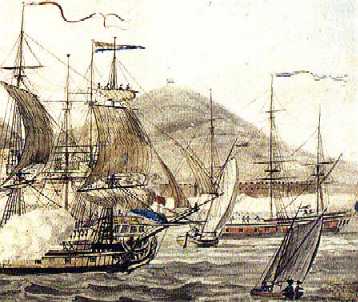|
|
|
The wreck of HMS
Havick 1800
HMS Havik was a sloop of 365 tons, she was 101 ft 10 ins in length, 28 ft 8 ins in the beam and had a draft of 12 ft 9 ins. She carried 16 x 6lb guns which varied between 6ft and 8ft 6ins in length and weighed between 17cwt and 22cwt. The shorter and lighter 12-pounder carronades weighed about 6cwt.
She had a crew of 121 and these would probably have included 15-18 marines (1 sergeant, 1 corporal and 13-16 privates) – a rule of thumb was one marine to each cannon. It also warranted a surgeon and a surgeon's assistant
In the late summer of 1800 Commander Philip Bartholomew was ordered to cruise between the Channel Islands and the Ile de Batz, just off Roscoff in Brittany. Because he was unacquainted with the area, Bartholomew sailed to Jersey to pick up a pilot familiar with the area. On the 3rd of November she lost her best bower anchor and had to rely on the sheet anchor to hold her. As there was no spare available, Bartholomew had a temporary anchor made from a pair of guns and some iron ballast. It was in this manner that she was lying at anchor on the Men of Wars' Ground - La Grande Rade de St Aubin - in St Aubin's Bay on the evening of the 8 November.
The storm
Vicious winds began to blow from the south-west during the early part of the night and continued to build towards dawn. By about 8:00am most of the vessels at anchor in the Rade de St Aubin, both Royal Navy and Merchantmen, were in distress and began to fire their canon to summon help but the sea was so rough that small boats were prevented from being launched to help. The fifth rate frigate, La Loire, 48 guns, Captain Newman parted her cables and lost her anchors as she passed over a rock ledge behind Elizabeth Castle as she managed to make for open waters and safety. Once clear of the bay she made for the shelter of Spithead on the Isle of Wight. By 11:00am the storm had reached hurricane force and was so fierce that trees were "ripped from the breast of the earth' and those ships at anchor in St Aubin’s Bay were trapped on what every sailor feared – a lee shore. On board the Havick things were becoming serious. She parted her cable and despite her temporary anchor she began drifting onshore. All the masts were cut away and the canon on the main deck were jettisoned, but she still made water.
According to Le Gazette de l'île de Jersey (15 November 1800) ..."Le Havick frégate de 26 canons" was the first to be driven ashore having lost its masts and anchors. Another vessel the Pelican (18 canons) was broken up on the rocks behind Elizabeth Castle while the gunboat, Spiteful, and two large merchant ships (one Swedish) were broken on the sands between St Helier and St Aubin. Havick was torn from her temporary anchor and forced to lose her masts and was wrecked on the beach between First Tower and West Park. The conditions were such that the storm winds held the sea up to its high water level. Miraculously none of the crew drowned and many islanders turned out to help the sailors as they scrambled up the beach against the tide. Both crews of the sloops managed to reach shore safely. The strength of the gale was such that it was said that the men had to crawl up the beach as the winds made it impossible to walk upright.
The Gazette's confusion over the number of guns could stem from the rating system ignoring the carronades and the description of the Havick as a frigate is understandable because from a landsmen's view both a ship-sloop and a frigate were three masted single deckers. The rating system meant that only a ship's long guns were counted and carronades were ignored until 1817
In late November the Times carried the following announcement:-
"November 11, Portsmouth
Arrived the Redbridge, schooner, Lieutenant Lempriere from Jersey much damaged. She brings an account of the loss of His Majesty's sloops Pelican of 18 guns, Captain Thicknesse and the Havick of 18 guns, Captain Bartholomew in St Aubin's bay, in the island of Jersey during a most violent gale of wind. The crew were all saved."
The Redbridge was a 16 gun schooner, commanded by Lieutenant Lempriere. He managed to claw his way out of the bay and made for Spithead. By the time Lempriere reached safety he had been forced to get rid of all of his guns to lighten his ship.
Miraculously none of the crew drowned and many islanders turned out to help the sailors as they scrambled up the beach against the tide. The Havick filled with water very quickly and started settling down in the sand. When the tide ebbed she was left high and dry and she appears to have settled down even further. After several attempts were made to refloat the stricken vessels all but one were successful. The Havick was so badly damaged that she was abandoned as a wreck.
Without a ship the crews of both the Havick and the other vessel, Pelican were transported back to Plymouth on board the 40 gun frigate L’Ambuscade, the Hon. Captain Colville. On their return they said that they had remained on board for nearly six hours as the mountainous waves crashed over them, They were only saved when the wind direction swung round to the north and pushed the high tide out. The shipwrecked crew were able to leave but they lost all their possession.
Click here to continue with the
How the Havick was foundClick here to find out
Which other ships were in St Aubin's Bay that nightClick here to return to
Patrimoine